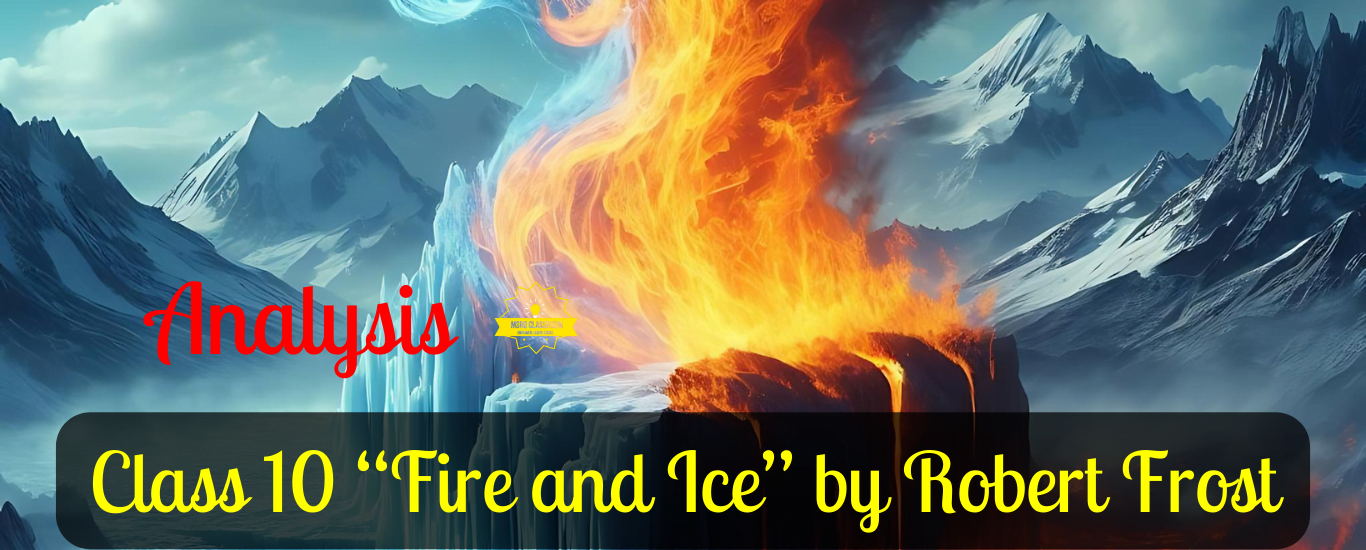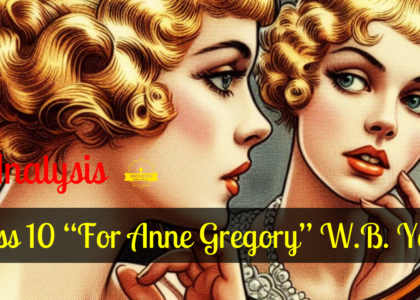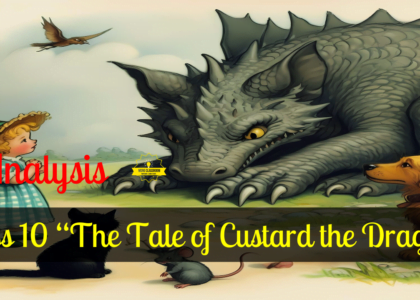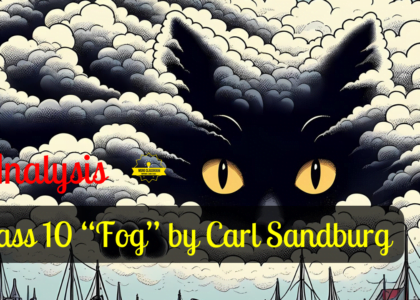Poem 2, Robert Frost’s “Fire and Ice” Summary, Theme, Explanation, Analysis, Line-by-Line Explanation, Literary Devices, Question Answers and Extract Based Questions.
Poem 2- Fire and Ice by Robert Frost:
Robert Frost
Robert Frost (1874-1963) was an American poet renowned for his evocative verse and contemplative themes. He captivated readers with his accessible yet profound poetry, often exploring rural life, nature, and human experiences.
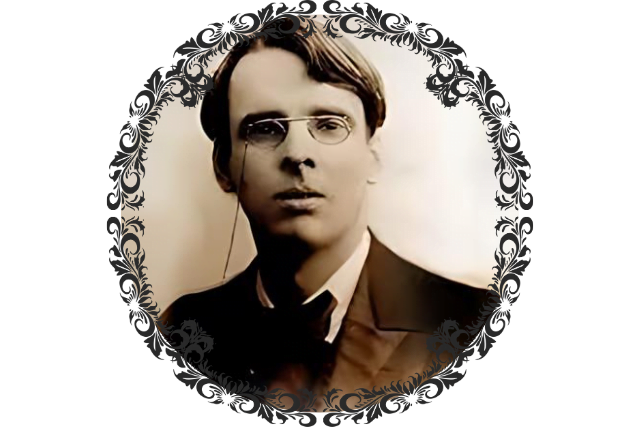
Table of Contents
Next on First Flight: Chapter 2- Nelson Mandela: Long Walk to Freedom, Poem 3- A Tiger in the Zoo
Fire and Ice” was first published in Harper Magazine in 1920. The poem was included in Frost’s New Hampshire collection and speaks to humanity’s capacity for self-destruction. This was a critical period in history as it marked the aftermath of World War I, where technological advancements collided with the devastating reality of global conflict. The poem prompts us to reflect on whether progress, measured by technological, economic, and intellectual achievements, is worth the potential destruction.
Summary “Fire and Ice”:
‘Fire and Ice’ by Robert Frost is a short and thought-provoking poem that contemplates the potential causes of the world’s end and reflects on human emotions and their destructive capacities. The poem explores the potential causes of the world’s end through the symbolic elements of fire and ice, representing desire and hate. The speaker aligns with those who believe in fire, emphasising the destructive power of unchecked desire.
However, the poem acknowledges that hate, symbolised by ice, is also capable of causing destruction. Frost delves into the impact of human emotions, suggesting that desire and hate can lead to catastrophic consequences. Through this exploration, the poem raises questions about the nature of human emotion and its role in shaping the world’s fate.
Central Idea: Fire and Ice:
“Fire and Ice” by Robert Frost centralises the destructive potential of human emotions, particularly desire and hate. Frost contemplates the causes of the world’s end through the symbolic imagery of fire and ice. The poem suggests that both intense desire, represented by fire, and profound hate, symbolised by ice, possess the capacity to lead to destruction. Frost prompts reflection on the multifaceted nature of human emotions and their consequences, highlighting their significant role in shaping the course of the world. The central idea revolves around recognising the power and danger inherent in unchecked desires and intense hatred, urging readers to contemplate the impact of these emotions on both personal and global levels.
“Fire and Ice” Explanation:
‘Fire and Ice’ is a concise yet impactful poem by Robert Frost, published in 1920. The poem has nine lines and explores the themes of destruction, desire, and human emotions.
- The first two lines introduce the poem’s central question: “Some say the world will end in fire, / Some say in ice.” These two elements, fire and ice, symbolise different forces that can bring about the end of the world.
- In the following few lines, Frost studies the characteristics of each element and how they might contribute to the world’s demise. “From what I’ve tasted of desire” suggests that desire, often associated with passion and intense emotions (symbolised by fire’s consuming nature), could destroy the world.
- On the other hand, “I hold with those who favor ice” indicates Frost’s inclination towards the idea that the world will end in ice. Ice represents coldness, apathy, and indifference, which can be equally destructive in a different way. It may allude to humanity’s absence of emotions, and compassion can lead to catastrophic consequences.
- The last two lines are thought-provoking: “For destruction ice is also great / And would suffice.” Here, Frost emphasises that both fire and ice are potent enough to bring about the world’s end. It is a reminder of the capacity for destruction inherent in human nature and the contrasting paths that can lead to such an outcome.
‘Fire and Ice’ is a contemplative poem that explores the dual nature of human emotions and behaviours. It presents a stark choice between fiery passion and icy indifference, which can lead to destruction. The poem serves as a cautionary reflection on the human condition and the potential consequences of unchecked emotions and indifference in society.
Analysis “Fire and Ice”:
‘Fire and Ice’ by Robert Frost is a compact yet profound poem that delves into the human psyche, exploring themes of destruction, desire, and the contrasting elements of fire and ice. Frost’s vivid imagery and concise language allow the poem to convey significant meaning and provoke thought in just a few lines.
Rhyme Scheme:
ABAA BCBCB. The rhyme scheme is essential to the poem’s structure, contributing to its rhythmic flow and overall impact. The poem is one quatrain and a quintain (five line stanza).
Type:
‘Fire and Ice’ by Robert Frost is a short, lyrical poem that falls into the category of modernist poetry. It is known for its concise and thought-provoking nature. Modernist poetry often explores complex themes using brief and vivid language. It frequently challenges conventional forms and expectations, as seen in ‘Fire and Ice.’
Structure:
The poem is written in a simple, conversational style and does not adhere to a strict metrical pattern, such as iambic pentameter. Its brevity/shortness and structure contribute to its impact, as it succinctly conveys its message about the destructive potential of human emotions.
Tone:
Robert Frost’s tone in Fire and Ice can be described as contemplative, detached, and matter-of-fact. Frost presents the poem with a straightforward and unemotional demeanour, as if he is analysing the subject from a distance without getting emotionally involved.
Frost’s detached tone can be seen in his acknowledgement of the destructive nature of both fire and ice without expressing personal preferences or emotions. He remains neutral while considering the possibilities, leaving the interpretation and judgment to the reader.
Symbolism:
Through the metaphor of fire, Frost represents desire, passion, and intense emotions that can consume and destroy. The idea that the world could end in fire suggests that unchecked human desires and passions if left unbridled, may lead to catastrophic consequences.
Ice symbolises indifference, coldness, and apathy. Frost acknowledges that this lack of emotion can also be equally destructive. The concept of the world ending in ice highlights the potential consequences of a society devoid of empathy and compassion, where individuals become indifferent to the suffering of others.
Frost’s presentation of the contrasting elements of fire and ice invites readers to contemplate their emotions and behaviours. He prompts us to consider the consequences of uncontrolled desire and impassivity in our lives and the impact they might have on the world at large.
The brevity/briefness of the poem contributes to its impact. In just nine lines, Frost conveys profound insights about the human condition, leaving readers with a lasting impression and room for personal interpretation. This is a hallmark of Frost’s style, using simple language and everyday settings to explore complex and universal themes.
Theme “Fire and Ice”:
‘Fire and Ice’ explores several significant themes through concise and evocative verses.
Following are some of the key themes in the poem are:
- Destruction:
The poem contemplates the destructive potential of human emotions and behaviours. The elements of fire and ice serve as metaphors for desire and indifference, both of which can lead to devastating consequences.
- Desire and Passion:
Fire symbolises desire, passion, and intense emotions. Frost’s portrayal of fire as a force that could end the world suggests that unchecked and uncontrolled desires may lead to destruction.
- Indifference and Apathy:
Ice represents indifference, coldness, and apathy. Frost’s acknowledgement that the world could end in ice implies that a society devoid of compassion and empathy can be equally destructive.
- Human Nature:
The poem delves into the complex nature of human emotions and the contrasting aspects of human behaviour. It prompts readers to reflect on their own emotional tendencies and the impact they can have on the world.
- Moral Choices:
By presenting the contrasting elements of fire and ice, Frost raises questions about moral choices and their consequences. Readers are encouraged to contemplate the ethical implications of their actions and attitudes.
- Complexity of Existence:
In just a few lines, Frost addresses the complexity of existence and the many factors that can influence human life and the world.
(Important)
- Universality:
The poem’s themes of destruction, desire, and indifference are universal and timeless, making it relevant and relatable across different cultures and time periods.
‘Fire and Ice’ is not merely a reflection on the end of the world but serves as a cautionary reflection on the potential destructive capabilities within each individual. Frost’s skilful use of metaphor and imagery challenges readers to confront their emotions, desires, and attitudes, encouraging introspection and a deeper understanding of humanity’s capacity for both creation and destruction.
Line-by-Line Explanation “Fire and Ice”:
- Some say the world will end in fire,
- Some say in ice.
In the opening lines, Frost presents the poem’s central theme—the possible ways the world might end. He personifies different viewpoints by saying, “Some say,” as if referring to different individuals or groups with contrasting opinions. One group believes the world will end due to fire, while the other believes it will end due to ice.
- From what I’ve tasted of desire
- I hold with those who favor fire.
Frost expresses his own perspective. He has “tasted desire,” implying he has experienced passionate emotions. He aligns with those who think the world will end in fire. This suggests he believes human desires, symbolised by fire, have the potential to lead to destruction.
- But if it had to perish twice,
- I think I know enough of hate
Frost now introduces a hypothetical scenario where the world would end not just once but twice. In this case, he reflects on his knowledge of “hate.” This line implies that hate, a powerful emotion associated with destruction, might be another factor contributing to the world’s end.
- To say that for destruction ice
- Is also great
In these lines, Frost presents the counter-argument to his earlier stance. He acknowledges that “ice,” symbolises indifference and coldness, is equally capable of causing destruction. This suggests that apathy and lack of emotion can also have catastrophic consequences.
- And would suffice.
In the final line, Frost concludes the poem by emphasising that fire and ice are potent enough to bring about the world’s end. The word “suffice” means that either element alone would be sufficient to cause destruction, reiterating the idea that both human desires (fire) and indifference (ice) can be equally destructive forces.
To conclude, ‘Fire and Ice’ is a compact and thought-provoking poem that explores the destructive potential of human emotions and behaviours. It leaves readers to contemplate the impact of the human condition and the choices we make as individuals and as a society.
Literary Devices “Fire and Ice”:
Question Answers “Fire and Ice”:
Textbook Question Answers:
Q1: There are many ideas about how the world will ‘end’. Do you think the world will end some day? Have you ever thought what would happen if the sun got so hot that it ‘burst’, or grew colder and colder?
A1: (Subjective Answer) Thinking about the world ending one day is scary. It’s hard to imagine everything just stopping. Sometimes, I wonder what would happen if something big like the sun suddenly changed, like if it got too hot and burst or if it started getting colder and colder.
In science class, we’ve discussed the sun eventually running out of fuel and becoming a red giant, but that’s supposed to be billions of years from now. It’s interesting to think about but also hard to grasp.
For now, I think I’ll just focus on what’s happening in my life and hope that scientists can figure out how to deal with any big changes that might happen in the future.
Q2: For Frost, what do ‘fire’ and ‘ice’ stand for? Here are some ideas:
A2: For Frost, “fire” and “ice” symbolise intense human emotions and attitudes that have the potential to lead to destruction. “Fire” represents desires such as greed, avarice, lust, and fury, which can consume and ravage individuals and societies.
On the other hand, “ice” embodies qualities like coldness, indifference, insensitivity and hatred, which can freeze relationships and foster cruelty. Both elements serve as metaphors for the darker aspects of human nature, highlighting the destructive consequences of unchecked desires and emotional coldness. Frost uses these symbols to explore the multifaceted nature of human emotions and their capacity to shape the world’s fate.
Q3: What is the rhyme scheme of the poem? How does it help in bringing out the contrasting ideas in the poem?
A3: Robert Frost’s “Fire and Ice” rhyme scheme is ABAA BCBCB. This rhyme scheme contributes to the poem’s structure and helps emphasise the contrasting ideas in each stanza. The consistent rhyme scheme creates a sense of rhythm and balance, drawing attention to the juxtaposition of “fire” and “ice” in each couplet.
This structure highlights the poem’s exploration of contrasting elements, as each stanza pairs a different aspect of desire (represented by fire) with a contrasting aspect of hatred (represented by ice). The rhyme scheme thus enhances the poem’s thematic exploration by highlighting the duality and balance between these opposing forces, ultimately emphasising their equal potential for destruction.
Extra Questions “Fire and Ice”:
Q1: What is the poem ‘Fire and Ice’ about?
A1: The poem ‘Fire and Ice’ by Robert Frost contemplates the possible ways the world might end. It presents two opposing elements, fire and ice, as symbols of desire (passion) and indifference, respectively. The poem explores the destructive potential of human emotions and behaviours, raising questions about the choices humanity makes and their consequences.
Q2: What are the themes in ‘Fire and Ice’?
A2: The main themes in ‘Fire and Ice’ are destruction, desire, indifference, human nature, moral choices, environmental awareness, and the complexity of existence. The poem delves into the profound aspects of the human condition and the contrasting forces that can lead to catastrophic outcomes.
Q3: What is the tone of the poem?
A3: The tone of ‘Fire and Ice’ can be described as contemplative, detached, and matter-of-fact. Frost presents the contrasting elements of fire and ice without expressing personal emotions, allowing readers to reflect on the themes and draw their interpretations.
Q4: How does the poem explore human emotions and behaviours?
A4: The poem explores human emotions and behaviours through the symbolic elements of fire and ice. Fire represents desire, passion, and intense emotions, while ice symbolises indifference, coldness, and apathy. Frost contemplates how unchecked desires, feelings, indifference, and lack of empathy can lead to destruction.
Q5: What is the poet’s perspective on how the world might end?
A5: In the poem, Robert Frost presents two viewpoints. He aligns himself with those who believe the world will end in fire, suggesting desire and passionate emotions might be a significant cause of destruction. He acknowledges that ice (indifference and hate) could end the world. The poet seems impartial and presents both perspectives without favouring one.
Q6: What message does the poem convey to readers?
A6: ‘Fire and Ice’ serves as a cautionary reflection on the human condition and the potential consequences of unchecked emotions and indifference in society. It prompts readers to contemplate their emotions and behaviours, encouraging introspection and awareness of humanity’s capacity for both creation and destruction.
Q7: How does using elements like fire and ice contribute to the poem’s meaning?
A7: The poem uses elements like fire and ice to symbolise human emotions and behaviours. Fire represents desire, passion, and intense emotions, while ice symbolises indifference, coldness, and apathy. By employing these elemental forces, Frost emphasises the contrasting aspects of human nature and the potential for both passionate destruction and apathetic indifference in shaping the world’s fate.
Q8: How might the poem be interpreted as a reflection on human relationships?
A8: The poem can be interpreted as a reflection on human relationships by considering how the elements of fire and ice relate to emotional dynamics between individuals. Fire may represent intense passion or desire in relationships, leading to great connection or destructive conflict. Ice could symbolise emotional distance or apathy, resulting in relationships becoming cold and distant or emotional detachment.
Q9: Why do you think the poet chooses not to express personal preferences in the poem?
A9: The poet does not express personal preferences in the poem to maintain objectivity and allow readers to interpret it. By not revealing his personal stance, Frost emphasises the universality of the themes presented. He wants readers to think critically and explore their perspectives on the destructive potential of human emotions and behaviours.
Q10: How do the poem’s structure and short lines impact its impact?
A10: The poem’s structure, with short and compact lines, contributes to its impact by creating a sense of urgency and directness. The brevity of each line allows Frost to pack significant meaning into concise phrases, capturing readers’ attention and making each word and idea count. The short lines enhance the poem’s rhythm and flow are enhanced by the sharp lines, making it more memorable and thought-provoking.
Q11: What real-life examples might embody the themes presented in ‘Fire and Ice’?
A11: Real-life examples embodying the ‘Fire and Ice’ themes could include historical events driven by passionate desires or conflicts arising from indifference and apathy. For instance, wars and conflicts fueled by intense desires for power or resources (fire) have led to destruction. On the other hand, societal issues arising from apathy and lack of empathy, such as inaction towards climate change or humanitarian crises (ice), can also have devastating consequences.
Q12: How might the poem’s message apply to current global challenges and conflicts?
A12: The poem’s message applies to current global challenges and conflicts by highlighting the importance of understanding the destructive potential of human emotions and behaviours. It encourages introspection and empathy, reminding individuals and nations to consider the consequences of their actions and choices. By recognising the impact of both passionate desires and indifference, society can strive for more balanced and compassionate solutions to global issues.
Extract-Based Questions “Fire and Ice”:
Extract 1:
“Some say the world will end in fire
Some say in ice.
From what I’ve tasted of desire
I hold with those who favour fire.”
Q1: What are the two contrasting views mentioned in this extract about how the world will end?
A1: The two opposing views are that the world will end in fire or ice.
Q2: Why does the speaker favour the idea of the world ending in fire?
A2: The speaker tends to the concept of the world ending in fire because they have personally experienced desire and believe in the destructive power of strong emotions.
Q3: In the poem ‘Fire and Ice’ by Robert Frost, the speaker discusses the contrasting ideas of the world ending in fire or ice. How do the above lines reflect the speaker’s perspective on the end of the world?
A3: The speaker’s statement, “From what I’ve tasted of desire, I hold with those who favour fire,” in Robert Frost’s poem ‘Fire and Ice’ reflects the speaker’s perspective on the end of the world and their preference for the idea that the world will end in fire.
When the speaker says, “From what I’ve tasted of desire,” they refer to their experiences with intense human emotions and desires. These experiences have allowed them to understand the destructive power of such desires. In this context, fire symbolises the intensity of human passions, emotions, and desires. It represents the uncontrollable and consuming nature of these feelings.
By stating that they “hold with those who favour fire,” the speaker aligns themselves with the belief that the world will end in fire, signifying that the overwhelming force of human desires and emotions will destroy it. The preference for fire reflects the speaker’s perspective that intense human passions and unchecked desires have the potential to lead to catastrophic consequences, possibly even the end of the world.
In essence, the speaker’s statement emphasises the theme of human emotions and desires as powerful and potentially destructive forces, shaping their perspective on the world’s end in the poem.
Extract 2:
“But if it had to perish twice,
I think I know enough of hate
To say that for destruction ice
Is also great
And would suffice.”
Q1: Under what conditions does the speaker contemplate the world perishing twice?
A1: The speaker contemplates the world perishing twice hypothetically.
Q2: Why does the speaker consider ice a viable destruction option?
A2: The speaker considers ice a viable option for destruction because they believe they have enough knowledge of hate to understand the potential for destruction that comes with emotional coldness and indifference.
Q3: In the poem “Fire and Ice” by Robert Frost, the speaker contemplates the idea of the world perishing twice and considers ice a viable agent of destruction. How does this stanza reflect the complex relationship between human emotions and the potential for a global catastrophe, and what is the significance of the speaker’s acknowledgement of hate as a destructive force?
A3: In this stanza, Robert Frost delves into the profound connection between human emotions and the potential for global catastrophe. The stanza captures the notion that the world could face destruction not once but twice, suggesting the dire consequences of unchecked human behaviours/emotions.
The key theme here is the interplay of emotions and their capacity for destruction. While the earlier part of the poem focuses on desire and passion, symbolised by fire, this stanza introduces the equally destructive force of hate, represented by ice. It acknowledges that human emotions, whether fiery desire or icy hatred, can potentially lead to catastrophic outcomes, not only on a personal level but also on a global scale.
The significance of the speaker’s acknowledgement of hate lies in its universality and the revelation that emotions like hatred, when left unchecked, can lead to devastating consequences. Frost invites readers to reflect on the destructive power of emotions and their potential impact on the world, emphasising the need for understanding and restraint in human interactions. Ultimately, the stanza/extract highlights the idea that the world’s end can be brought about by the extremes of human emotion, whether fiery or icy, making it a profound commentary on human nature and its implications for society and the world.

